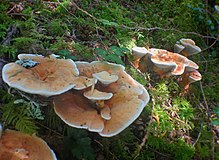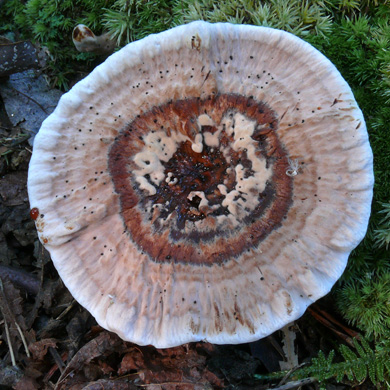Map Snapshot


13 Records
Status
Found solitary or scattered on ground under conifers.
Description
Cap: Flat to depressed; occasionally fused with other caps or with aborted mini-caps on top of main cap; surface velvety with ridges and bumps; dry; flesh brown, zoned, tough, fibrous; unpleasant odor when cut. Fertile surface: Crowded reddish-brown spines (1.5-2-5 mm). Stalk: Orange to rusty-brown, cylindrical to somewhat irregular; sometimes spongy near base (J. Solem, pers. comm.).
Seasonality Snapshot
Source: Wikipedia
| Hydnellum aurantiacum | |
|---|---|

| |
| Scientific classification | |
| Domain: | Eukaryota |
| Kingdom: | Fungi |
| Division: | Basidiomycota |
| Class: | Agaricomycetes |
| Order: | Thelephorales |
| Family: | Bankeraceae |
| Genus: | Hydnellum |
| Species: | H. aurantiacum
|
| Binomial name | |
| Hydnellum aurantiacum | |
| Synonyms[1] | |
Hydnellum aurantiacum is an inedible fungus, commonly known as the orange spine or orange hydnellum for its reddish orange or rusty red colored fruit bodies. Like other tooth fungi, it bears a layer of spines rather than gills on the underside of the cap. Due to substantial declines in sightings, this species is listed as critically endangered in the United Kingdom.[2][3]
Taxonomy
[edit]Hydnellum aurantiacum was first described by the German naturalist August Batsch in 1789, with the name Hydnum suberosum var. aurantiacum.[4] It was given its current scientific name by Petter Karsten, who transferred it to Hydnellum in 1879.[5] Hydnellum aurantiacum has acquired several synonyms in its taxonomic history, including Hydnum stohlii, published by Gottlob Ludwig Rabenhorst in 1873, and Hydnellum complectipes, published by Hall in 1972.[6] Additional synonyms resulting from generic transfers include Hydnum aurantiacum (Johannes Baptista von Albertini and Lewis David de Schweinitz, 1825); Calodon aurantiacus (Karsten, 1881); and Phaeodon aurantiacus (Joseph Schröter, 1888).[1]
The specific epithet aurantiacum is derived from the Latin for "orange". Common names for the fungus include "orange spine",[7] "orange corky spine fungus",[8] and the British Mycological Society approved English name "orange Hydnellum".[9]
Description
[edit]
Fruitbodies are shallowly funnel-shaped (infundibuliform), and up to 15 cm in diameter. The upper surface is orange or orange-brown in the centre, with a lighter margin. It may be velvety or tomentose when young, but will become wrinkled or lumpy in age. The flesh is tough and woody, pale to dark orange-brown in color, without any distinctive odor but a bitter or mealy taste.[10] The teeth are short (up to 5 mm long), white, but the tips gradually turn brown with age. The stipe is up to 4 cm long and 0.5–2 cm thick, orange to dark brown in color, with a velvety surface.[11] The spore print is brown. This species is inedible[12] due to the toughness of the flesh and its poor taste.[13]
Basidia (the spore-bearing cells) are between 35 and 46 by 8–11 μm, club-shaped (clavate), without clamp connections, and four-spored. The sterigmata (extensions of the basidia bearing spores) may be up to 6 μm long. Basidiospores are roughly spherical in shape, with rough warty outgrowths (tubercles), nonamyloid, and have dimensions of 5.5–8 by 5.5–6.5 μm.[14]
Similar species
[edit]The species resembles the polypore Phaeolus schweinitzii when viewed from the top of the cap surface, but it has teeth instead of pores on the hymenium. Closely related and morphologically similar species in the genus Hydnellum include H. auratile (has more uniformly coloured flesh), H. caeruleum (may look similar in age),[15] H. congenum (has thin flesh in the cap), H. ferrugipes, H. earlianum (has a smoother cap, and spines have sulfur-yellow tips, not white).[7][16]
Distribution and habitat
[edit]| Hydnellum aurantiacum | |
|---|---|
| Teeth on hymenium | |
| Cap is flat or depressed | |
| Stipe is bare | |
| Spore print is brown | |
| Ecology is mycorrhizal | |
| Edibility is inedible | |
This species is typically found growing solitary or in clusters on the ground in conifer and mixed woods. Rarely, fruit bodies may have their stipes fused together.[6] Hydnellum aurantiacum has been reported from Australia,[17] Europe, North America,[18] and Asia, including China[19] India,[20] and Korea.[21] It is one of the most frequently encountered Thelephorales species found in the Sverdlovsk region of Russia.[22]
Chemistry
[edit]
The pigment responsible for the characteristic orange color of H. aurantiacum has been identified as the p-terphenyl compound named aurantiacin.[23] This dark red pigment, a derivative of the compound atromentin, has subsequently been identified in other species of Hydnellum.[24] The compounds dihydroaurantiacin dibenzoate and thelephoric acid have also been reported.[25]
Hydnellum aurantiacum is used in mushroom dyeing, in which it produces grayish to greenish-gray colors depending on the mordant used.[26]
References
[edit]- ^ a b "GSD Species Synonymy: Hydnellum aurantiacum (Batsch) P. Karst". Species Fungorum. CAB International. Retrieved 2015-09-16.
- ^ "Trees for Life - Species Profile: Pinewood tooth fungi". Archived from the original on 2008-12-06. Retrieved 2009-01-05.
- ^ "Action plan for Grouped plan for tooth fungi". Archived from the original on 2008-10-08. Retrieved 2009-01-05.
- ^ Batsch AJGK. Elenchus fungorum. Continuatio secunda. Halae Magdeburgicae: Apud Joannem J. Gebauer. p. 103.
- ^ Karsten PA. (1879). "Symbolae ad mycologiam Fennicam. VI". Meddelanden Af Societas Pro Fauna et Flora Fennica (in Latin). 5: 15–46 (see p. 41).
- ^ a b Hall D, Stuntz DE (1972). "Pileate Hydnaceae of the Puget Sound area. III. Brown spored genus: Hydnellum". Mycologia. 64 (3): 560–590. doi:10.2307/3757873. JSTOR 3757873.
- ^ a b McKnight VB, McKnight KH (1987). A Field Guide to Mushrooms, North America. Boston, Massachusetts: Houghton Mifflin. pp. 92–93. ISBN 978-0-395-91090-0.
- ^ Pegler DN, Roberts PJ, Spooner BM (1997). British Chanterelles and Tooth Fungi. Kew, UK: Royal Botanic Gardens. p. 80. ISBN 978-1-900347-15-0.
- ^ "Recommended English Names for Fungi in the UK" (PDF). British Mycological Society. Archived from the original (PDF) on 2011-07-16.
- ^ Orr DB, Orr RT (1980). Mushrooms of Western North America. California Natural History Guides. Berkeley, California: University of California Press. p. 55. ISBN 978-0-520-03660-4.
- ^ Ellis JB, Ellis MB (1990). Fungi without Gills (Hymenomycetes and Gasteromycetes): an Identification Handbook. London: Chapman and Hall. p. 105. ISBN 978-0-412-36970-4.
- ^ Phillips, Roger (2010). Mushrooms and Other Fungi of North America. Buffalo, NY: Firefly Books. p. 320. ISBN 978-1-55407-651-2.
- ^ Miller Jr., Orson K.; Miller, Hope H. (2006). North American Mushrooms: A Field Guide to Edible and Inedible Fungi. Guilford, CN: FalconGuides. p. 406. ISBN 978-0-7627-3109-1.
- ^ Baird RE, Khan SR (1986). "The stipitate Hydnums (Thelephoraceae) of Florida USA". Brittonia. 38 (2): 171–184. doi:10.2307/2807273. JSTOR 2807273. S2CID 85360191.
- ^ Trudell, Steve; Ammirati, Joe (2009). Mushrooms of the Pacific Northwest. Timber Press Field Guides. Portland, OR: Timber Press. pp. 231–232. ISBN 978-0-88192-935-5.
- ^ Arora D. (1986). Mushrooms Demystified: A Comprehensive Guide to the Fleshy Fungi. Berkeley, California: Ten Speed Press. p. 626. ISBN 978-0-89815-169-5.
- ^ May TW, Milne J, Shingles S, Jones R (2003). Fungi of Australia: Catalogue and bibliography of Australian fungi 2. Basidiomycota p.p. & Myxomycota p.p. v. 2B. Csiro Publishing. p. 313. ISBN 978-0-643-06907-7.
- ^ Miller OK, Miller H (2006). North American Mushrooms: A Field Guide to Edible and Inedible Fungi. Falcon Guide. p. 406. ISBN 978-0-7627-3109-1.
- ^ Dai Y-C. (2010). "A revised checklist of corticioid and hydnoid fungi in China for 2010". Mycoscience. 52: 69–79. doi:10.1007/s10267-010-0068-1. S2CID 86049359.
- ^ Lyngdoh A, Dkhar MS. "Wood-rotting fungi in East Khasi Hills of Meghalaya, northeast India, with special reference to Heterobasidion perplexa (a rare species ‒ new to India)" (PDF). Current Research in Environmental & Applied Mycology. 1 (1): 114–124.
- ^ Lee JS, Jung HS (2005). "List of recorded Korean Aphyllophorales" (PDF). Korean Journal of Mycology. 33 (1): 38–53. doi:10.4489/kjm.2005.33.1.038.
- ^ Shiryaev A. (2008). "Diversity and distribution of thelephoroid fungi (Basidiomycota, Thelephorales) in the Sverdlovsk region, Russia" (PDF). Folia Cryptogamica Estonica. 44: 131–144.
- ^ Gripenberg J. (1956). "Fungus pigments. IV. Aurantiacin, the pigment of Hydnum aurantiacum Batsch". Acta Chemica Scandinavica. 10: 1111–1115. doi:10.3891/acta.chem.scand.10-1111.
- ^ Velíšek J, Cejpek K (2011). "Pigments of higher fungi: A review". Czech Journal of Food Sciences. 29 (2): 87–102. doi:10.17221/524/2010-CJFS.
- ^ Gripenberg J. (1958). "Fungus pigments. IX. Some further constituents of Hydnum aurantiacum Batsch" (PDF). Acta Chemica Scandinavica. 12: 1411–1414. doi:10.3891/acta.chem.scand.12-1411.
- ^ Bessette AR, Bessette A (2001). The Rainbow Beneath My Feet: A Mushroom Dyer's Field Guide. Syracuse, New York: Syracuse University Press. p. 117. ISBN 978-0-8156-0680-2.




